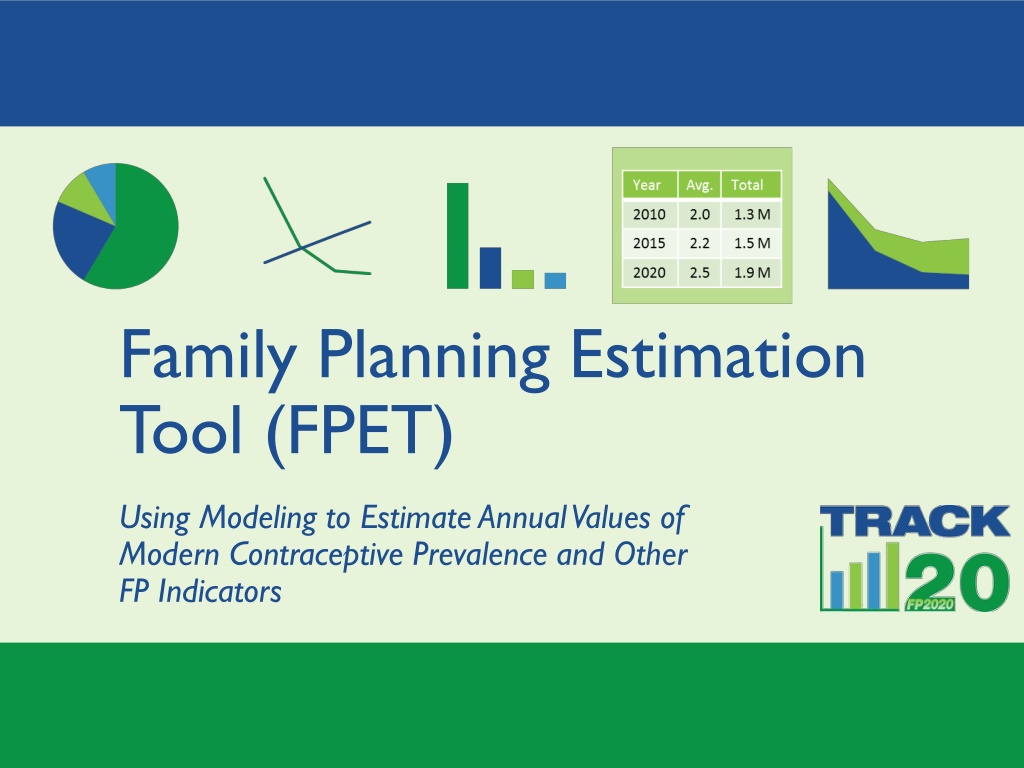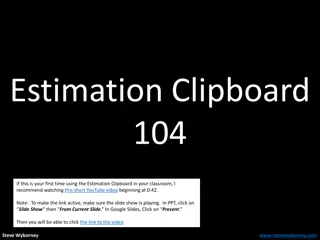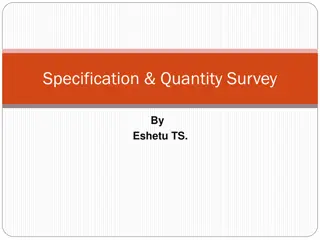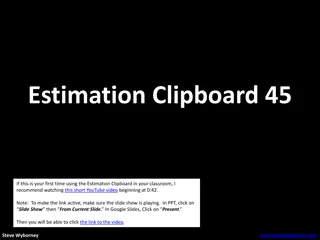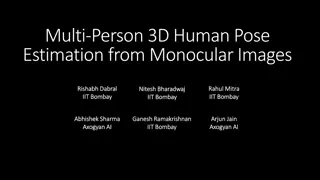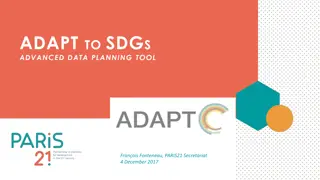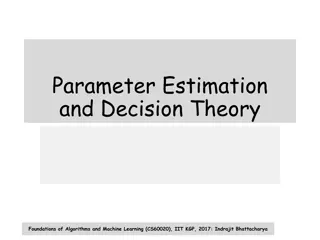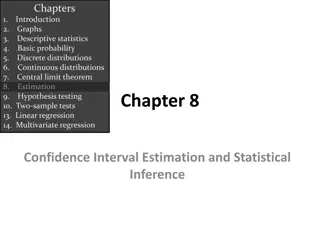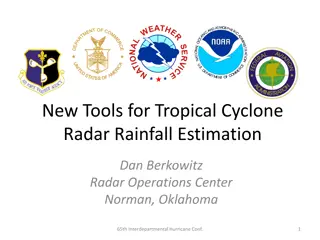Family Planning Estimation Tool (FPET)
Explore the importance of monitoring FP indicators annually and using modeling to estimate modern contraceptive prevalence rates (mCPR) through the Family Planning Estimation Tool (FPET), along with case studies and the need for annual estimates to track progress effectively.
Download Presentation

Please find below an Image/Link to download the presentation.
The content on the website is provided AS IS for your information and personal use only. It may not be sold, licensed, or shared on other websites without obtaining consent from the author.If you encounter any issues during the download, it is possible that the publisher has removed the file from their server.
You are allowed to download the files provided on this website for personal or commercial use, subject to the condition that they are used lawfully. All files are the property of their respective owners.
The content on the website is provided AS IS for your information and personal use only. It may not be sold, licensed, or shared on other websites without obtaining consent from the author.
E N D
Presentation Transcript
Family Planning Estimation Tool (FPET) Using Modeling to Estimate Annual Values of Modern Contraceptive Prevalence and Other FP Indicators
Objectives 1. Why monitor FP indicators annually? 2. Why use modeling to estimate mCPR? 3. What is FPET and what are its origins? 4. What are the advantages to using FPET? Case studies 2
Why do we need annual estimates? Because countries normally have 5-year strategies, waiting 5 or more years between national surveys for data limits a country s ability to monitor progress. Without annual data how do we answer the questions: What proportion of women are using modern contraceptives? Are our family planning programs having the impact we expect/want? Are we making progress? We need annual estimates for key family planning indicators to answer these questions and understand how we are progressing. 4
How can we best estimate current mCPR? 1. Use the most recent survey? 2. Extrapolate the trend from the last two surveys? 3. Extrapolate the trend from the last three surveys? 4. Extrapolate the trend from all available surveys? 5. Service statistics can provide annual estimates but are they accurate? Measures of mCPR in Bangladesh 60 50 ? 40 30 mCPR = The percentage of women of reproductive age who are using (or whose partner is using) a modern contraceptive method at a particular point in time. 20 10 0 1989 2011 1975 1977 1979 1981 WFS 1983 1985 1987 1991 CPS 1993 1995 1997 1999 DHS 2001 2003 2005 2007 SS 2009 2013 2015 5
Different surveys may give very different results mCPR (MW) from Surveys : 2003-2015 30 MICS3 24.9 PMA 28.64 25 DHS 22.2 DHS 18.7 PMA 21.4 20 DHS 16.6 mCPR (MW) PMA 18.2 MICS3 14 PMA 17.59 LSMS 16.7 15 Previously we may have attempted to estimate current mCPR and project future trends based solely on past survey trends which may give radically different results. 10 5 0 2003.5 2004.5 2005.5 2006.5 2007.5 2008.5 2009.5 2010.5 2011.5 2012.5 2013.5 2014.5 2015.5 2014 6
Using Modeling to Estimate Annual mCPR Already done in: HIV field Maternal Mortality Ratio Child survival programs Similar methodologies are appropriate in FP Have the advantage of lessons learned from these other fields
Track20s Family Planning Estimation Tool (FPET) 8
An Existing Model Provides the Framework for FPET UN Population Division (UNPD) has an estimation model that already produces annual estimates of key family planning indicators: CPR mCPR Traditional Method Use Unmet Need for Modern Contraception Demand Satisfied by Modern Contraception Sources: 1. Alkema L, Kantorova V, Menozzi C, Biddlecom A. National, regional, and global rates and trends in contraceptive prevalence and unmet need for family planning between 1990 and 2015: a systematic and comprehensive analysis . Lancet 2013; published online March 12. http://dx.doi.org/10.1016/S0140-6736(12)62204-1.
Track20 Built on UNPD Framework to create the Family Planning Estimate Tool (FPET) Modifications to the UNPD Model 1.One Country Version Ability to run one country at a time (UNPD model runs all countries and takes multiples days) Prior assumptions on some parameters are informed by regional and sub-regional values from global model 2.Potential to Add Service Statistics to Inform Estimates 1. Informs projection past the last survey point 2. Estimates are anchored by surveys 3. Allows for estimates to be modified based on annual data, so we can see if we are continuing on the same trajectory, or shifting the line up or down 3.Available Online for Open Use
Track20 Built on UNPD Framework to create the Family Planning Estimate Tool (FPET) Key Differences 1. Databases UN database is larger Closes their database earlier than Track20 2. Country dynamics UN treats all countries the same if there is available data they will include it, unless specifically asked by the country not to. Track20 works with countries individually and is able to jointly make decisions to include additional data or exclude some data. 3. Lactational Amenorrhea Method (LAM) is recorded differently in select countries 11
What is FPET? FPET is designed to use all available data to develop annual estimates of three indicators commonly used to track progress in a family planning program beyond the date of the last survey and into the future. FPET calculates annual estimates for 3 common FP indicators: numberofwomenusingmodern contraception totalnumberofwomen (????????? ??????????? ?????) Modern Contraceptive Prevalence (or CPR) m?? = ???? = numberofwomenwithunmetneedfor modern (including traditional users) totalnumberofwomen Unmet Need for Modern Methods (or unmet need) ?? ??? Demand for Family Planning Satisfied (or satisfied by any method) numberofwomenusingmoderncontraception numberofwomenusingcontraceptionandwithunmetneed for modern = 12
Model Methodology The UNPD Model & Track20 s FPET are both Bayesian hierarchical models A Bayesian hierarchical model is a statistical model that estimates the likelihood of a given result based on prior observed values and is informed by data at multiple levels. For the purpose of producing annual estimates of contraceptive prevalence, these models incorporate: multiple sources of data (surveys: National, DHS, MICS, PMA, Service Statistics) data points over time (survey results and trends: CPR, mCPR, Unmet Need) different levels of data (country/regional/global) Using this information, the model aims to provide the best estimate of each indicator given all available data and an estimate of the confidence interval around each data point.
Incorporating Multiple Data Sources and Levels FPET uses data from a wide range of sources to inform annual estimates of key family planning indicators. Sources include: DHS National and International Surveys MICS PMA2020 Service Statistics 14
Incorporating the Family Planning S-Curve mCPR typically grows in a S-Shaped pattern, with growth starting out slow at low levels of mCPR, accelerating with rapid growth for a period and then levelling off as mCPR reaches a maximum level. This pattern is incorporated into the model, determining the potential rate of growth in mCPR based on previous national, regional and global trends as well as the level of mCPR.
Fitting a Curve to Survey Data The model creates thousands of potential curves, searching for the curve/trend that best fits the data provided for a given country. This curve is used to estimate the current value for Contraceptive Prevalence and develop projections for future years.
Communicating the Value of FPET in 4 Case Studies 17
FPET is useful when you have: 1. A lot of survey data (varying types of surveys) 2. Conflicting survey information 3. Little data 4. Outdated data 18
1. When you have a lot of data survey(of varying types) Nigeria mCPR MW Trends for Nigeria by Source mCPR MW Trends for Nigeria by Source 18 16.316.1 18 16 16.3 16.1 16 14 11.6 14 12 10.8 11.6 10.5 10.8 12 10 10.5 10.9 10.5 10.9 10.5 9.8 10 8 9.7 9.8 9.7 8 8.6 8.2 8.6 8.2 6 6 PMA PMA 4 4 MICS MICS National Surveys National Surveys DHS DHS 2 2 3.5 3.5 0 0 FPET 1990 1990 1991 1991 1992 1992 1993 1993 1994 1994 1995 1995 1996 1996 1997 1997 1998 1998 1999 1999 2000 2000 2001 2001 2002 2002 2003 2003 2004 2004 2005 2005 2006 2006 2007 2007 2008 2008 2009 2009 2010 2010 2011 2011 2012 2012 2013 2013 2014 2014 2015 2015 2016 2016 2017 2017 Nigeria has many different surveys Different levels can make interpretation difficult when looking at them individually When combined, all are telling the same narrative of minimal growth see a common trend
2. When you have lots of conflicting information Ghana 2000-2015: - 10 Surveys - 4 Different types of survey (DHS, MICS, PMA, & National) - Shifting survey values can cause confusion and make it difficult to develop a narrative around change in Ghana. - There can also be politics associated with using one survey over another when discussing the current situation mCPR (MW) from Surveys : 2003-2015 30 MICS3 24.9 PMA 28.64 25 DHS 22.2 DHS 18.7 PMA 21.4 20 DHS 16.6 mCPR (MW) PMA 18.2 MICS3 14 PMA 17.59 LSMS 16.7 15 10 5 0 2003.5 2004.5 2005.5 2006.5 2007.5 2008.5 2009.5 2010.5 2011.5 2012.5 2013.5 2014.5 2015.5 2014 20
Ghana: conflicting information FPET takes into account all of the data available for Ghana, as well as regional and global trends in growth in mCPR to create one estimate trend, incorporating the uncertainty around the estimate and variability between surveys. mCPR (MW) from Surveys & FPET: 2003-2015 30 In this case, FPET can help create a single narrative of progress and avoid the challenges of choosing one data point or debating the merits of the available data/studies. More data is better and FPET uses it all to inform estimates. 25 25.1 20 21.5 20.9 20.9 20.8 mCPR (MW) 19.6 18.3 17.517.116.716.316.817.2 15 10 5 0 2003.5 2004.5 2005.5 2006.5 2007.5 2008.5 2009.5 2010.5 2011.5 2012.5 2013.5 2014 2014.5 2015.5 21
Conflicting information: differing surveys between years PMA2020 DHS MICS FPET 22
3. When there is very little data Somalia 1970-2019: - Only 2 MICS (1999 & 2006) - Difficult to discuss progress or changes when there is so little data, but we know (based on regional and global trends) that prevalence is not likely to be stagnant - FPET uses hierarchical data to inform the trend in mCPR, providing a growth narrative (with caveats note the confidence interval), rather than an unchanged estimate from 13 years ago. Survey (2006) mCPR (MW) FPET (2019) mCPR (MW) 1.2% 3.7% With FPET estimate, we see conservative estimate of .19% pt growth per year. 23
4. When our data is outdated Sierra Leone Last Survey: 2013 DHS - FPET allows us to estimate progress (based on existing data as well as what we know about mCPR growth S Curve) rather than rely on outdated survey - When 2017 MICS results came out, FPET results were largely validated. - FPET can now be updated with the new data to produce even better estimates going forward. Survey (2013) mCPR (AW) FPET (2017) mCPR (AW) MICS (2017) mCPR (AW) 22.1% 25.9% 25.5% FPET estimated .95% pt growth per year. Survey indicated .85% pt growth per year 24
Service statistics can improve our estimates Cote D Ivoire 1980-2015: - 5 Surveys - Last Survey as in 2011 (Before FP2020) , but we know that with FP2020 and OP, it is likely that prevalence is growing - Cote d Ivoire has consistent trends in service statistics (clients), overlapping with the last survey, that indicate a steady upward trend. - Incorporating service statistics: - provides more data on recent trends (especially important in short-term monitoring) - gives more confidence in the estimate - supports use of government data - promotes country ownership of estimates CI (95%) 2016.5 8.8% - 24.7% 15.9% pt spread CI (95%) 2016.5 11.3% - 19.6% 8.3% pt spread 25
Advantages to Using FPET FPET allows for better understanding of country progress & provides alternative to relying on last (sometimes outdated) survey it provides annual estimates FPET provides annual estimates, surveys are generally every 5 years. FPET uses the same methodology as the UN and in the HIV field FPET supports governments in using data produced through public sector health services. FPET can be applied at the decentralized level to produce estimates of key family planning indicators. FPET is available online and can be used by anyone, encouraging more transparency and ownership of the results. FPET can be used to compare multiple surveys that might show similar and/or dissimilar trends The methodology has been widely accepted and is an innovation in FP monitoring SS can produce better estimates when other data sources are limited or outdated. Using SS data also encourages review and investment in SS systems Subnational use of FPET & the ability to produce estimates is particularly important in the era of decentralization and targeted national family planning programs. Track20 is training MEOs in country to use the model, encouraging country ownership of the process and the results, for global reporting and country-level monitoring. Use all existing information from various surveys
http://fpet.track20.org @track20project www.track20.org
